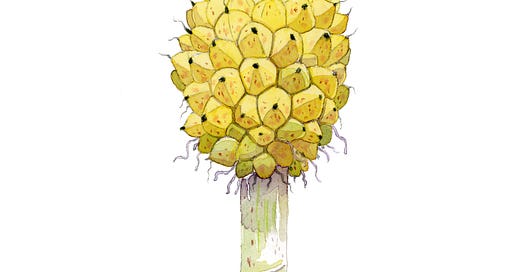Four species of banana from the genus Musa are indigenous to Australia Aboriginal Land: Musa Banksii, Musa fitzalanii, Musa jackeyi and Musa acuminata. The world’s oldest evidence of banana cultivation is the Musa Banksii species found at Kuk Swamp in Papua dating between 6,900 to 6,400 years old.
Torres Strait Islanders have been cultivating bananas for over 2,000 years, the oldest evidence being found at Wagadagam on the island of Mabuyag in the Torres Strait.
The common commercial cultivated sweet banana is a hybrid of Musa acuminata and Musa balbisiana. The Musa acuminata species is indigenous to the tip of Cape York in Queensland. It was introduced to the Continent by Torres Strait Islanders approximately 2000 years ago.
The Musa fitzalaniia and Musa jackeyi species of banana are endemic to Aboriginal Land. The Musa fitzalaniia, which was found only in the Daintree River region of Queensland is now believed to be extinct. The Musa jackeyi banana is an endangered species found in the Johnstone River region of north-east Queensland.
Torres Strait is a colonial name referring to Spanish coloniser Luis Váez de Torres.
Cape York is a colonial name referring to Frederick of York whose brother, George III, held power during the British invasion and colonisation of Aboriginal Land.
The Daintree is a colonial name referring to British coloniser Richard Daintree, who surveyed natural resources on stolen Aboriginal Land for exploitation.
Johnstone River is a colonial name referring to Robert Arthur Johnstone, a British colonial police officer on stolen Aboriginal Land.
Queensland is a colonial name referring to Alexandrina Victoria, who held power during the British invasion and colonisation of Aboriginal Land.
REFERENCES
https://www.anu.edu.au/news/all-news/indigenous-banana-cultivation-dates-back-over-2000-years
https://www.nature.com/articles/s41559-020-1278-3
https://www.bbc.com/news/world-australia-53746652
https://www.ogtr.gov.au/sites/default/files/files/2021-06/the_biology_of_musa_l_banana.pdf



